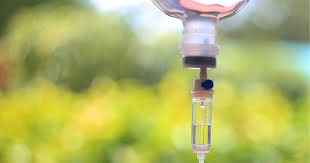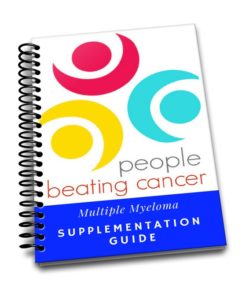
Recently Diagnosed or Relapsed? Stop Looking For a Miracle Cure, and Use Evidence-Based Therapies To Enhance Your Treatment and Prolong Your Remission
Multiple Myeloma an incurable disease, but I have spent the last 25 years in remission using a blend of conventional oncology and evidence-based nutrition, supplementation, and lifestyle therapies from peer-reviewed studies that your oncologist probably hasn't told you about.
Click the orange button to the right to learn more about what you can start doing today.
- You are here:
- Home »
- Blog »
- Multiple Myeloma »
- Myeloma Stage 1- R,V,D Induction, I.V. Vit. C, Over-Diagnosis?
Myeloma Stage 1- R,V,D Induction, I.V. Vit. C, Over-Diagnosis?

Intravenous vitamin C (ascorbic acid and L-ascorbic acid) therapy is the ideal integrative, complementary, non-toxic, evidence-based therapy for multiple myeloma patients and survivors.
Greetings David! Thank you so very very much for the tremendous amount of information that you provide on PeopleBeatingCancer.org. I so wish I had the resources to do MM cancer coaching with you and dearly appreciate your being available to answer questions.
I read about IV Vitamin C therapy for MM and have located a place to be able to do that.
I am about 5 weeks in my first cycle of induction chemotherapy of revlimid, velcade and dexamethasone (RVD). I started on Dex though had a rough reaction to it and was taken off of it.
- No M-spike detected nor
- kidney damage thus far and very grateful.
- 30% detected with a BMB.
- I am IGg kappa.
I was also informed about oxygen therapy in a hyperberic chamber (HBOT) located at a clinic nearby. Is that something you would recommend as well as the I.V. Vitamin C infusion? Thank you so very much for your perspective and taking the time to answer me. Liz
- no m-spike,
- 30% mm cells in your blood (BMB) and
- no kidney involvement
- IgG Kappa,
- intravenous vitamin C therapy,
- anti-angiogenic nutrition and supplementation such as curcumin and omega-3 fatty acids,
- frequent, moderate exercise
- lifestyle therapies
- To Learn More about intravenous vitamin C therapy and Myeloma- click now
- To Learn More about Newly Diagnosed Multiple Myeloma Stage 1- click now
- MM Survivor
- MM Coach
- Director PeopleBeatingCancer
Recommended Reading:
What is the Salmon-Durie classification of multiple myeloma (MM)?
-
Hemoglobin value >10 g/dL
-
Serum calcium value < 12 mg/dL (normal)
-
Normal bone structure (scale 0) or only a solitary bone plasmacytoma on radiographs
-
Low M-component production rates (IgG value < 5 g/dL, IgA value < 3 g/dL, urine light-chain M component on electrophoresis < 4 g/24 h)
In stage II, the MM cell mass is 0.6-1.2 × 1012 cells/m2 or more. The other values fit neither those of stage I nor those of stage III.
In stage III, the MM cell mass is >1.2 × 1012 cells/m2, and all of the following are present:
-
Hemoglobin value < 8.5 g/dL
-
Serum calcium value >12 mg/dL
-
Advanced lytic bone lesions (scale 3) on radiographs
-
High M-component production rates (IgG value greater than 7 g/dL, IgA value greater than 5 g/dL, urine light-chain M component on electrophoresis greater than 12 g/24 h)
Subclassification A includes relatively normal renal function (serum creatinine value < 2 mg/dL), whereas subclassification B includes abnormal renal function (serum creatinine value > 2 mg/dL)
Median survival is as follows:
-
Stage I, >60 months
-
Stage II, 41 months
-
Stage III, 23 months
Multiple Myeloma- Intravenous Vitamin C Therapy
Intravenous vitamin C (ascorbic acid and L-ascorbic acid) therapy is the ideal integrative, complementary, non-toxic, evidence-based therapy for multiple myeloma patients and survivors.
…at least it is from my perspective as a long-term MMer and MM cancer coach. I believe that conventional chemotherapy regimens such as Velcade, Revlimid, Darzalex, etc. can kill MM. A two chemo regimen (doublet) kills more MM than a single regimen, a triple regimen kills more MM than a doublet, etc. etc.
Achieving remission after induction therapy, especially if you have minimal side effects is a great feeling. The two challenges for MMers are:
- collateral damage aka side effects from toxic therapies and
- MDR aka multi-drug resistance. Side effects can increase with the more chemo you have and the day will come when you relapse and conventional chemotherapy regimens no longer work.
The articles linked and excerpted below spell out how intravenous vitamin-C therapy kills or will weaken myeloma exposing your cancer to being killed by cytotoxic therapies or the evidence-based nutrition, supplementation and other therapies that show results in myeloma therapy.
If you or a loved one have been diagnosed with Multiple Myeloma, let me say this loud and clear:
It is critical that you become an active participant in your care. Learn everything you can.
I am alive today largely because I took the time to find out everything I could about Multiple Myeloma and sought out the full spectrum of evidence-based MM therapies both conventional (FDA approved) and non-conventional.
Your decision-making begins by learning about the full spectrum of evidence-based myeloma therapies, both conventional and non-conventional. To learn more about the Multiple Myeloma Coaching Course, click here.
Recommended Articles:
- Cannabidiol kills multiple myeloma and enhances Velcade against MM
- Antineoplaston Therapy (ANP)-From End Stage Multiple Myeloma to Complete Remission
- Multiple Myeloma Specialists- MM Cancer Coaching
Multiple Myeloma Tumor Cells are Selectively Killed by Pharmacologically-dosed Ascorbic Acid
“Multiple myeloma (MM) remains a difficult to cure disease in the majority of cases. Several preclinical and clinical studies have shown that ascorbic acid in pharmacologic doses (PAA) selectively kills cancer cells while sparing normal cells. This article reveals the biological mechanism by which PAA exerts its anti-cancer effects and should lead to the development of an innovative therapy in MM…”
Why high-dose vitamin C kills cancer cells
“Vitamin C breaks down to generate hydrogen peroxide, which can damage tissue and DNA. The new study shows that tumor cells with low levels of catalase enzyme activity are much less capable of removing hydrogen peroxide than normal cells, and are more susceptible to damage and death when they are exposed to high doses of vitamin C…
Most vitamin C therapies involve taking the substance orally. However, the UI scientists have shown that giving vitamin C intravenously — and bypassing normal gut metabolism and excretion pathways — creates blood levels that are 100 — 500 times higher than levels seen with oral ingestion. It is this super-high concentration in the blood that is crucial to vitamin C’s ability to attack cancer cells….”
Vitamin C in complementary oncology–update 2009.
“The antioxidant perhaps most widely used in complementary oncology is vitamin C, particularly by intravenous injection. In light of the recent clinical pharmacokinetic findings, the in vitro evidence of anti-tumor mechanisms and some well-documented cases of advanced cancers the role of high-dose intravenous vitamin C therapy in cancer treatment should be reassessed…”


